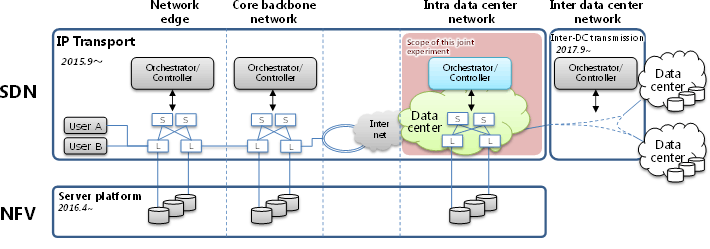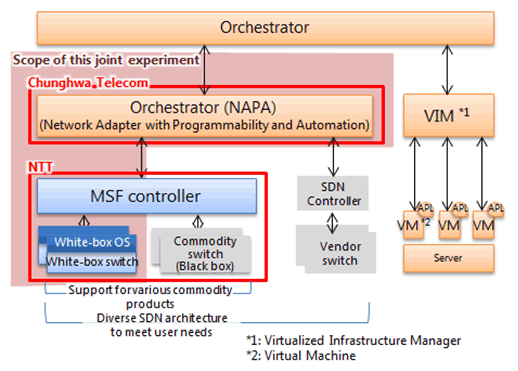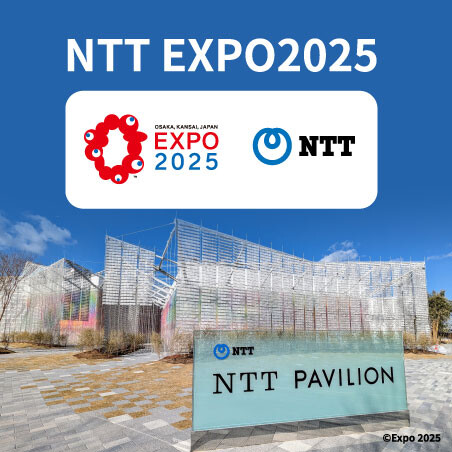Microsoft ends support for Internet Explorer on June 16, 2022.
We recommend using one of the browsers listed below.
- Microsoft Edge(Latest version)
- Mozilla Firefox(Latest version)
- Google Chrome(Latest version)
- Apple Safari(Latest version)
Please contact your browser provider for download and installation instructions.
December 12, 2017
Japan-Taiwan joint experiment successfully proves white-box based carrier-grade networking
- International service provider collaboration in SDN pushes forward IP packet transport to employ commodity products -
Nippon Telegraph and Telephone Corporation (Headquartered in Chiyoda-ku, Tokyo, President and CEO Hiroo Unoura; NTT hereinafter) and Chunghwa Telecom (Headquartered in Xinyi Road, Zhongzheng District, Taipei City, Taiwan, CEO Yu Cheng; Chunghwa Telecom hereinafter) succeeded in a joint experiment to verify the service continuity and reliability required by telecommunications carriers for virtual network control collaboratively with ITOCHU Corporation (Headquartered in Minato-ku, Tokyo, CEO Masahiro Okafuji; ITOCHU hereinafter) and ITOCHU Techno-Solutions Corporation (Headquartered in Chiyoda-ku, Tokyo, CEO Satoshi Kikuchi; CTC hereinafter). This experiment was enabled by the combination of NTT's Multi-Service Fabric (MSF hereinafter) and Chunghwa Telecom's orchestrator (NAPA). MSF is a technology to organize white-box switches to work as an IP transport network. NAPA is a technology to control various products in response to user requirements.
From 2015, the four companies began jointly studying SDN/NFV technologies with the aim of establishing network technologies to quickly respond to a wide range of needs with architecture that maximizes the use of commodity network products.
These experiments confirmed that highly reliable networks with high resistance to failure are possible by maximizing the functionality of white-box switches, which has led to further advances in studies on future application of white-box switches to commercial networks.
Background to join experiments and history of cooperation
In recent years, carriers are required not only to reduce the cost but also to provide networks that can respond quickly and flexibly to dramatic increase in traffic and diversification of uses. In order to realize that, it is becoming more important to utilize global use of common, generic technologies and products, not just relying on traditional carrier network products. This has led NTT and Chunghwa Telecom partner on solving issues across wide areas of telecommunications carrier networks (Figure 1).
 Figure 1 Cooperation between NTT and Chunghwa Telecom in the SDN/NFV field
Figure 1 Cooperation between NTT and Chunghwa Telecom in the SDN/NFV field
As collaboration in the SDN/NFV fields, studies began on IP transport SDN technologies from September 2015, on NFV technologies from April 2016, and on transmission SDN technologies between data centers from September 2017 [1].
In February 2017, four companies, NTT, Chunghwa Telecom, ITOCHU, and CTC, signed a memorandum of understanding (MoU) on joint research and experiments [2]. As well as commonization of SDN technologies to achieve networks that will satisfy various needs, the four companies agree to proactively use generic network products (switches etc.) under this MoU.
Regarding the IP packet transport SDN technology studies that have been ongoing since the outset of this partnership, studies on white-box switch applicability for dramatic reform of telecommunications carrier networks have been continuing in the following three areas: the network edges required to provide services to individual users, the core backbone networks requiring high-capacity packet transport capability, and data center networks crucial for cloud and enterprise systems. On this occasion, joint experiments have successfully confirmed the applicability of these switches in the area of data center networks.
These experiments ran for two weeks in the Chunghwa Telecom Laboratories in Taoyuan City, Taiwan, and finished on December 1. ITOCHU supported technical coordination and collaboration with Chunghwa Telecom and Taiwan manufacturers, while CTC provided white-box switch (hardware and software) integration support.
The technologies of the companies
NTT has been continuing with generalization of network equipment based on the NetroSphere concept [3], which includes MSF. MSF is not only a high-reliability SDN architecture but also a network technology which organizes and controls simple commodity products provided by multiple vendors. NTT published the technology as open source software in October 2017 [4].
Meanwhile, orchestrator NAPA research and development has been ongoing at Chunghwa Telecom. This technology provides uniform control methods with a GUI and also enables network states to be understood easily for multiple SDN architectures.
In this collaboration, we have been studying and developing MSF and NAPA technologies aiming to apply more merchant-silicon based network products such as white-box switches to carrier networks.
Details of this joint experiment
This data center network area joint experiment was performed through the combining of NTT and Chunghwa Telecom technologies on a network to which white-box switches were applied. Specifically, virtual network configuration and control technologies using white-box switches and white-box switch operating systems were verified by controlling MSF from NAPA (Figure 2).
 Figure 2 Data center service structure and scope of this joint experiment
Figure 2 Data center service structure and scope of this joint experiment
Using simulations to confirm failures assumed to occur in telecommunications carrier network operations such as redundancy with controller failures, automatic communications route switching with white-box switch failures, these experiments confirmed reliability that enables service continuity.
Future development
Based on the knowledge gained from these joint experiments, NTT and Chunghwa Telecom are engaging in details technical studies and experiments for the use of generic products such as white-box switches in commercial data center services. Studies to experimentally verify applicability in the area of telecommunications carrier IP network edges and core backbone networks are continuing, as are studies on technical partnership between the two companies in the data center area to expand the scope of application outside data centers in the future.
As well as NTT's continuing studies on experiments oriented towards commercialization, the results of experiments and knowledge gained through this partnership will be extended to the open source community. With further advances in white-box switches applicability verification, NTT is aiming for high-reliability telecommunications carrier networks to meet various needs through global expansion of telecommunications carriers, vendors and integrators agreeing to these technologies via the Telecom Infra Project and Open Network Foundation.
[1]Started joint experiment for drastic labor saving / automation by applying open source technology to optical transmission network between data centers - Joint experiments with Chunghwa Telecom Laboratories toward application of open source software and white-box switch to optical transmission network -
http://www.ntt.co.jp/news2017/1710e/171031a.html
[2]Chunghwa Telecom Signs SDN / NFV Technologies Memorandum of Cooperation with Japan's NTT and ITOCHU Corporation (In Chinese)
http://www.cht.com.tw/aboutus/messages/msg-170216-111536.html
[3]NetroSphere: Towards the Transformation of Carrier Networks
- A novel R&D concept to innovate the network development by accelerating network functions modularization -
http://www.ntt.co.jp/news2015/1502e/150219a.html
[4]Multi-Service Fabric
https://github.com/multi-service-fabric/msf
Contact information
Nippon Telegraph and Telephone Corporation
Information Network Laboratory Group
Planning Department, Public Relations Section
Email: inlg-pr@lab.ntt.co.jp
Information is current as of the date of issue of the individual press release.
Please be advised that information may be outdated after that point.
NTT STORY
WEB media that thinks about the future with NTT

















